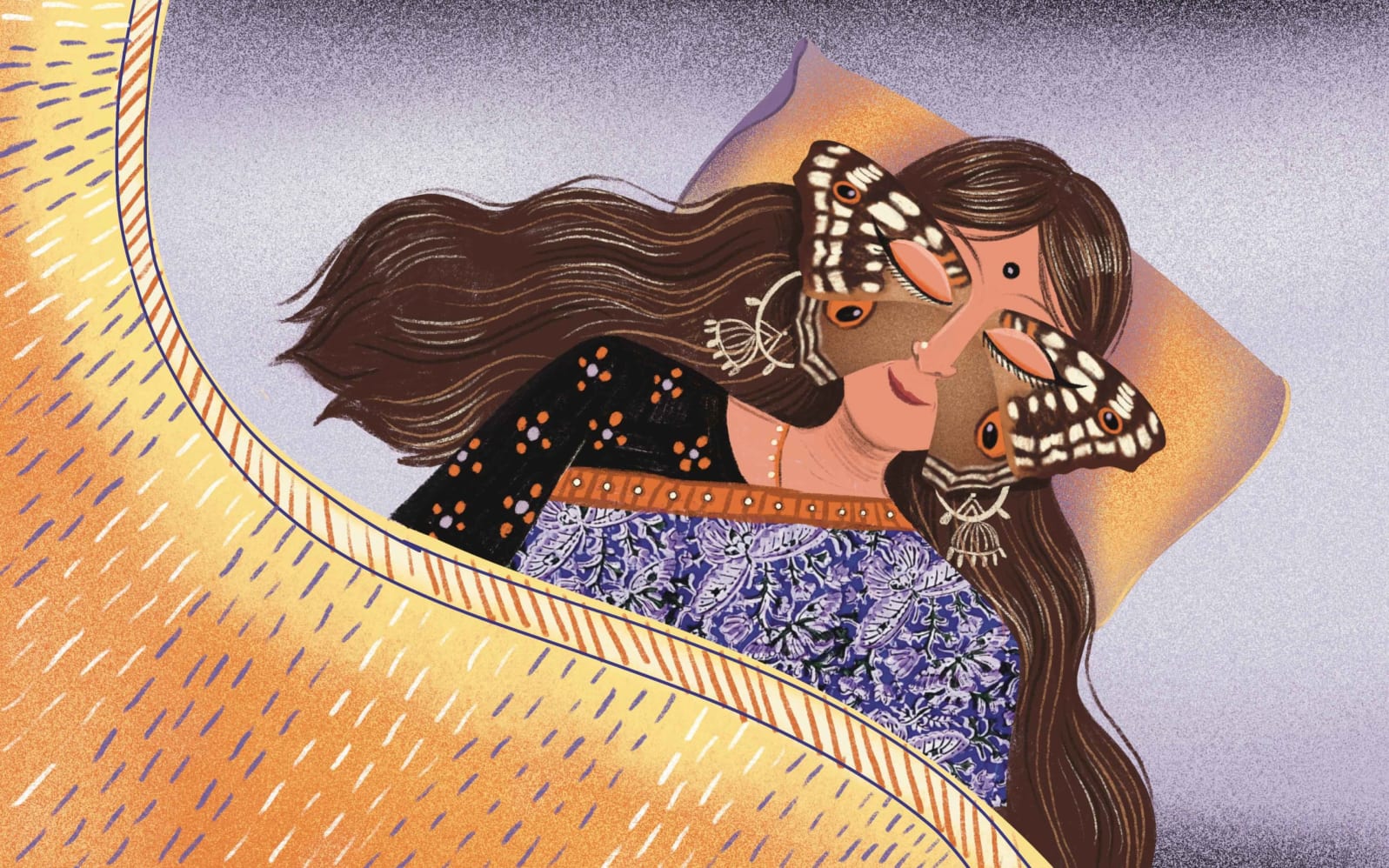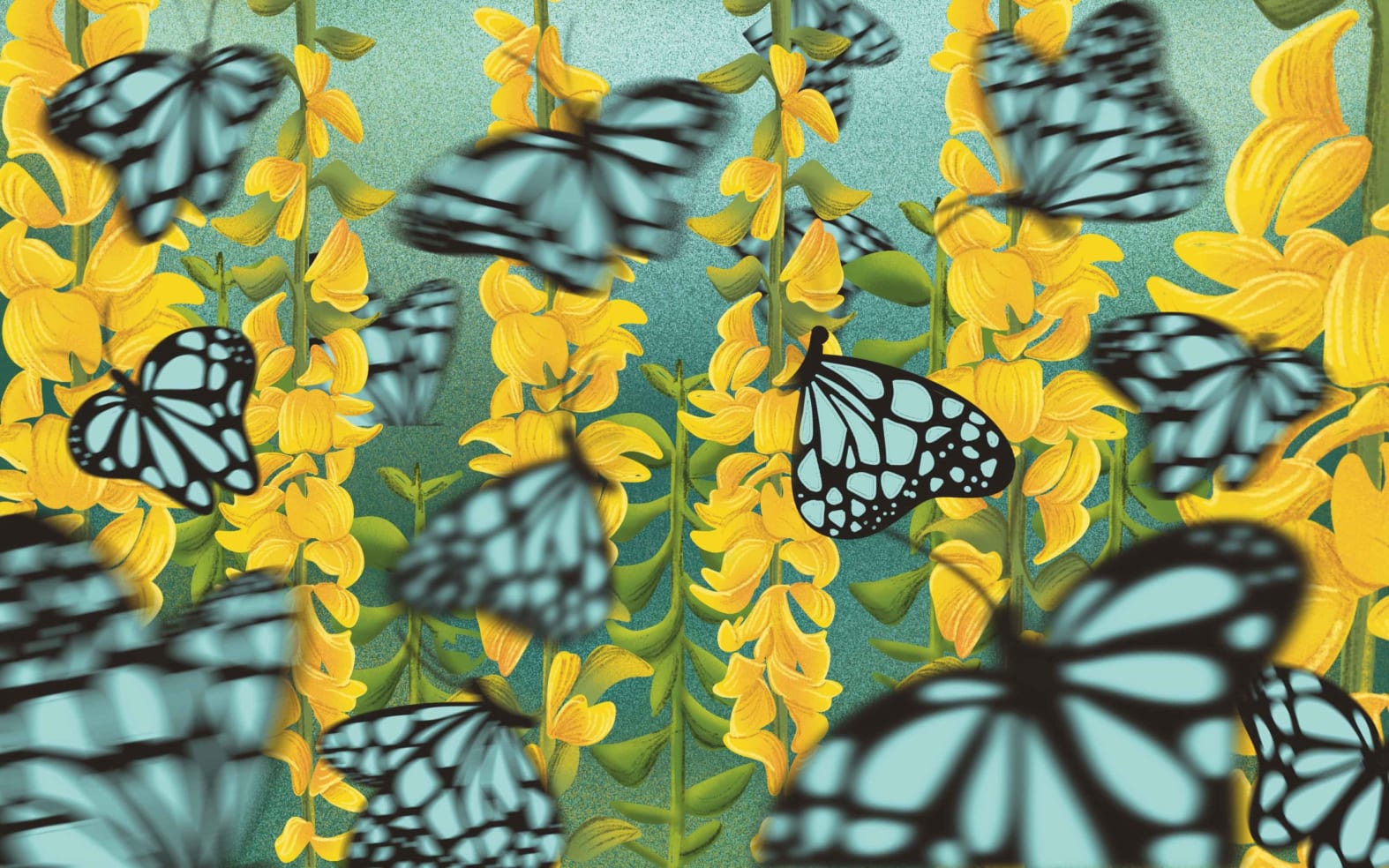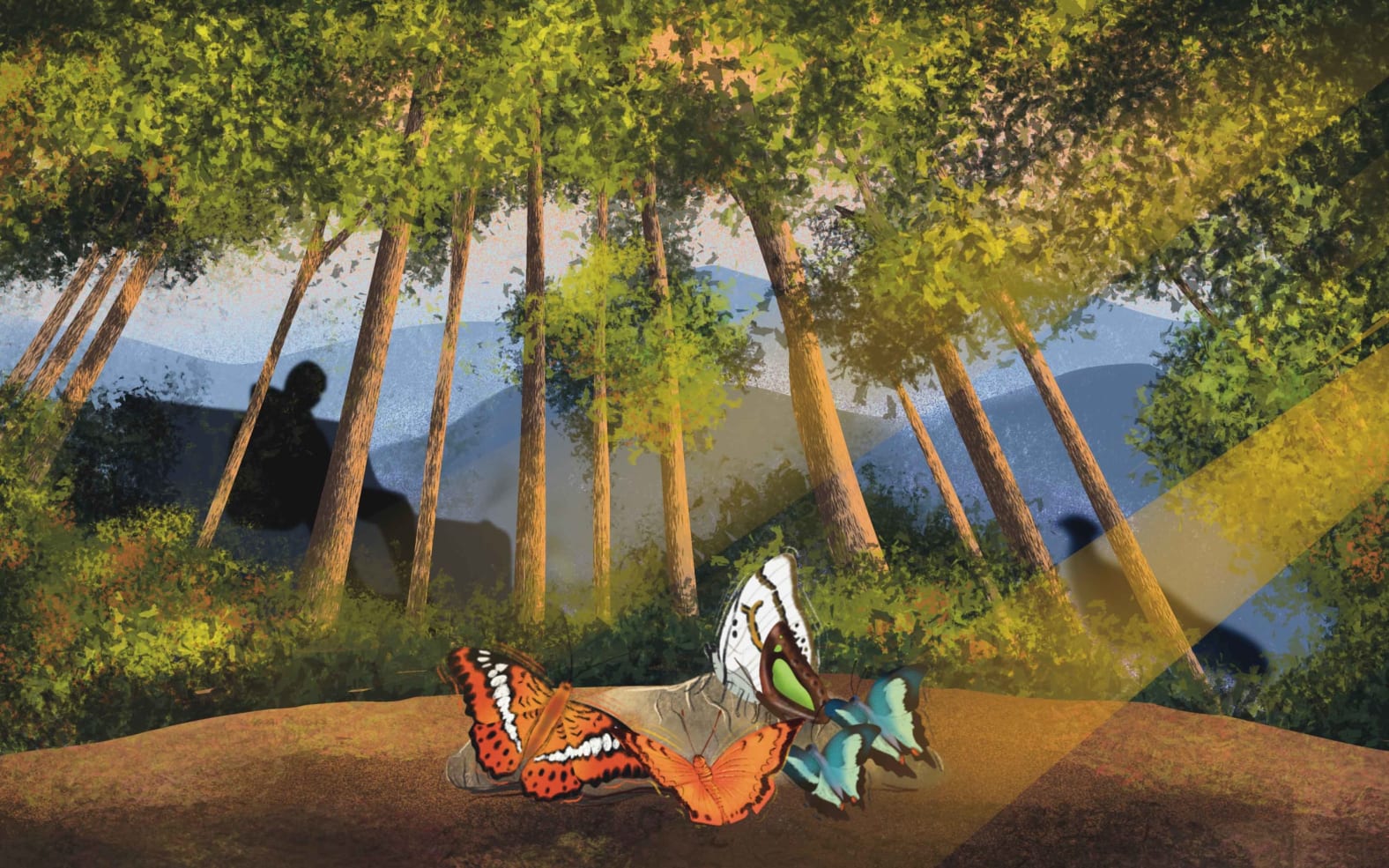 Listen to this article
•
15:34 min
Listen to this article
•
15:34 min
Broad-leaved trees sieve sunlight, turning it bright orange as it floods the forest floor. My shoes are soaked, eyes stinging, lower back stiff and stabbing after a sleepless night and cramped travel. The drying Panchai River turns like a knee-joint, and the day turns on itself inside Mahananda Wildlife Sanctuary in West Bengal.
A sunlit sandstone boulder on the riverside is covered in carrot shavings. No, it can’t be, look again. A sunlit sandstone boulder strewn aside by the river when it flowed in full force is covered in marigold petals or maybe scales. No, no, look again. They are opening and closing. I take one more step; the stone fragments into fifty flitting pieces like a letter torn to shreds. They were small leopard butterflies sucking moisture from the boulder’s surface, now fluttering above the noiselessly trickling river. Hundreds more, along the riverbanks, filled the tunnel of forest, throwing up tangerine waves as I walked further. The day’s mood flipped after such a serious violation of normality. It lingered like a spilling dream. As it does for anybody who has accidentally walked into a swarm of mud-puddling butterflies.

I felt wonder like weight loss that day, deep yet lightening, like gravity leaving. A place of feeling perhaps only butterflies can allow passage to.
In a checklist of “wonder” made into a Tamil song comes “Vanatthu poochi udambil oviyangal adhisayam” (art on a butterfly is a wonderful thing). Would wonder feel the same in the human psyche if we never lived with or witnessed butterflies in our history? Did butterflies, among other creatures, shape and feed our evolution of wonder? That specific kind of wonder which fuses dreams and daylight, feels fragile and fleeting, and can still stop the world’s time.

What experience was Tagore remembering when he wrote, “a butterfly does not count months but moments and has time enough…let your life lightly dance on the edges of time”. Chinese philosopher Chuang Tzu concludes in his butterfly poem, “Now I do not know /if I am a man dreaming I was a butterfly/or if, I am now a butterfly/dreaming I am a man”. He evokes the insect’s symbolic power to dissolve the separation between wakefulness and dream, him, and another.
The poet AK Ramanujan describes his wife’s sleeping face, saying, “blessed as by butterfly…” What is a blessing a butterfly can give? Perhaps it gives a form to desire and yearning, and complete freedom to dream in the way it streaks colour on sky and skin.
At a Chennai school, I once taught eighth-grade children how to draw a peacock pansy butterfly. One boy emptied his colour pencil box and shaded his drawing with every colour available. Each wing became a patchwork rainbow. For him, the butterfly was an archetype for complete creative freedom, unrestrained by my instruction and his normal experience.
Another Tamil song goes “Pattampoochi kootathukku patta edhuku” (a swarm of butterflies don’t need land-ownership documents). Here, butterflies help the lyricist imagine identities beyond individual and political borders through the way they float across fences and human-made boundaries, “commoning” them with such grace.
Our psyches are coevolutionary estuaries. Our emotional landscapes and the depths of our subconscious minds, as much as our physical ones, are joined and moulded by all the life we shared in our deep pasts as a species. The great psychoanalyst Carl Jung used the “bush soul” concept to indicate that the core of our psyche is one with all of life, and a lack of emotional participation with nature has created a sense of cosmic and unfathomable social isolation. Deep ecologists like Freya Mathews and Thomas Berry wrote of the “ecological self”, explaining that the real roots of our consciousness are braided into the entire evolution of life.

Meaning is a relational quality. We make sense of phenomena in terms of other phenomena. I am thinking of one of the Tamil words for love — paasam, which is also the word for moss and lichen (along with paasi and paasai), which embrace rocks and tree trunks. Or take the “veins” on butterfly wings or within our bodies; the word comes from Latin vena or small water channels. We evolved to understand our own selves using the sensations and experiences offered by the rest of nature. Our ecologies made and gave us symbolisms and routes in our psyches. The earliest and most prevalent archetypes humans use to make sense of the mind’s patterns and feelings are diversely animal.
In a psychic sense, the meaning of life is our relationality with all of life. And the richness of our inner lives — our ecological selves — reflects the richness of life we coexist with.
The loss of species and habitats around us is also a loss of psychic meaning, an erasure of feelings and passages that only other beings can allow into our own co-evolved selfhood. The ecological and psychological crises are then necessarily one. Conservation efforts also protect our own sanity as a species and provide meaning in our lives.
Would our minds be different if we never met butterflies in our lifetime? Imagine you have missed ever seeing one. What part of you might also be missing?
I had once taken college students into a park where two dozen blue tiger butterflies on a crotalaria plant exploded around into haphazard flight. Thirty humans stood stunned, eyes open, mouths agape. “Wow!”, “Holy!”, “Oh my god”, came involuntary exclamations between minutes of silence as blue and black wings dreamed around us. Wonder hit us like water on a windy day.
Mary Oliver wrote when possibly watching cabbage whites, “Seven white butterflies/delicate in a hurry look/how they bang the pages/of their wings…. all eternity/is in the moment”. I know this specific feeling well from watching butterflies.
Once, at Dehing Patkai forest, Assam, while I sat cross-legged in a jeep lane, it felt like my legs had grown roots into the ground and fixed them in place. Hundred feet over me were dipterocarp trees dropping seeds, spinning briskly to the ground. A khaleej pheasant kept throwing shrill tantrums deep in the jungle. Six feet before me was a lump of fresh leopard scat. Over it somehow were many-flavoured slices of cake. No, it can’t be, look again. On the leopard droppings, mist-soaked and stinging the nose, a stack of playing cards was stirring alive. No way, look properly. A small, glowing red book sails two circles around the spot and rejoins the rest. Six or seven butterflies are perched in a bouquet, drawing in salts the mammal has discarded. The great nawab butterfly was full-moon white with butterscotch lines on its veins, with four tail-tips like licks of woodfire. A yellow rajah butterfly with closed wings was like a withering leaf and sunflower-yellow when it bloomed open. It alternated between nonexistence and surprising colour. I thought of the lines by Moritake, a Japanese haiku master:
fallen blossom
returning to the branch?
ah, no—a butterfly
A commander butterfly, glowing red slashed with white, banged the pages of its wings around and then perched like open palms in prayer. Three common nawab butterflies quarrelled for a poop-crevice, entangling their proboscises. One by one, the low sun found their turquoise wing panels and lit them up like the Andaman Sea. Wonder felt like its proboscises probing into my skull.
To the question “What is the point of life?” at least a tiny bit of the answer for each of us is “butterfly”.








